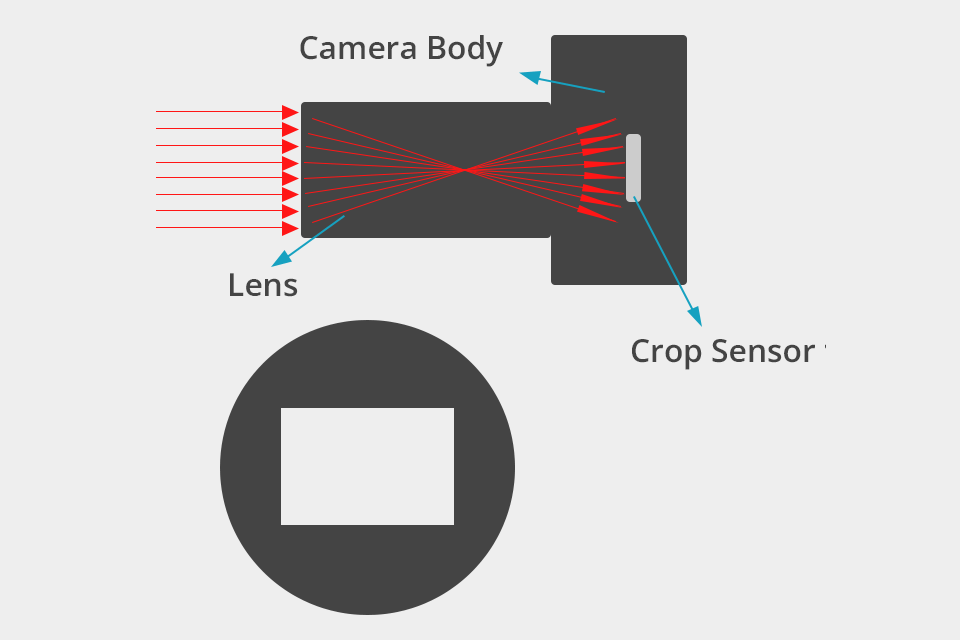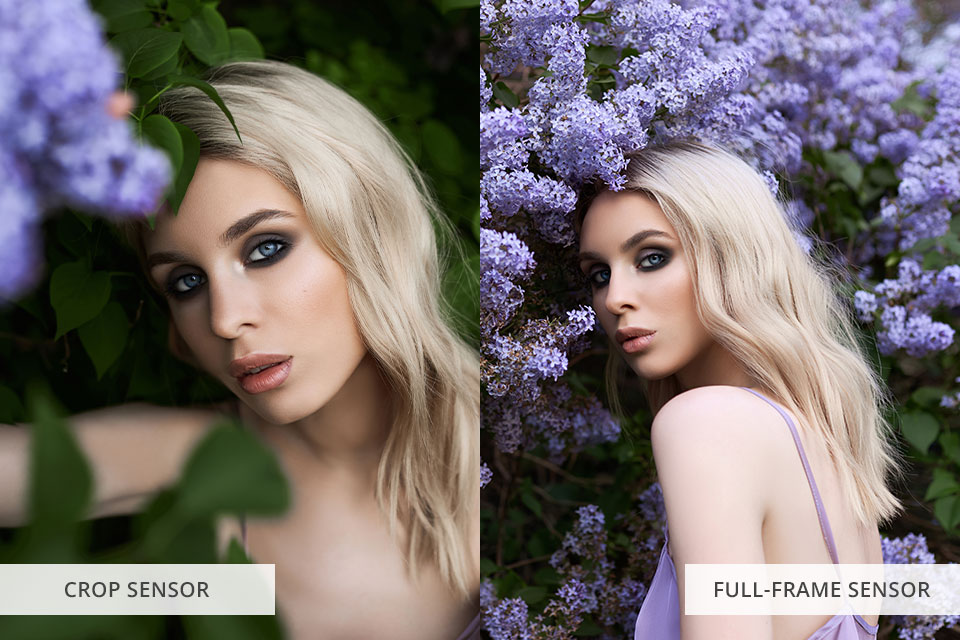
Comparing crop sensor vs full frame, the first thing we need to consider is the field of view. In general, the notion “crop” perfectly defines the difference. The smaller sensor’s FoV is a crop of the full frame. So, if you use a full frame and a crop sensor to take images from an identical distance, with the same lens and point of view, the latter will produce a tighter FoV.
Another difference worth considering is the cost. A new, full-frame camera comes with a hefty price tag of about $3000, while a crop analog is priced at approximately $1500.
If you are doubtful about what camera is best suited for your needs, you should read this review very attentively. I will describe both types in detail, as well as define their strong and weak points, and crucial differences. What’s more, I’ll give you the lowdown on what camera works best for particular shooting conditions and why.

A crop/cropped-frame camera is a device with a sensor smaller than an equivalent of a 35mm frame of a film camera. In most cases, such sensors have dimensions of 22.5x15mm or 24x16mm, but there may be exceptions.
In 1996 camera manufacturers presented an image sensor format called Advanced Photo System (APS). It was necessary to establish a crop sensor as a standard. In fact, there were 3 types of such a format – classic (C), high-definition (H), and panorama (P). Most modern digital cameras belong to the APS-C category. Canon EOS-1D Mark IV was the last camera released with a high-definition format sensor. It had a 1.3 crop factor. Though APS was phased out, you can still find cameras with a cropped sensor marked as APS-C, so the crop sensor vs full frame battle is relevant.
Every brand rolls out cameras with slightly different sensors in terms of size. For instance, Canon has a 1.6x crop factor, so cropped sensors are 1.6 smaller than counterparts embedded in a full-frame device. Sony, Pentax, Nikon, and Fuji offer a 1.5x crop factor. This is actually a very important point you need to keep in mind while selecting a suitable lens.
Cameras with a crop sensor are more affordable, as manufacturing a full-frame sensor requires more materials and involves more sophisticated processes. However, this doesn’t mean that crop sensors are trashy. In fact, there are lots of top-tier crop sensors that stay on par with full-frame analogs in terms of image quality.
Though it is impossible to pair a cropped frame lens with a full-frame camera body, you can easily do the opposite. Thus, an image in the lens will be bigger than the frame in the sensor, which will capture only those elements it “sees”. For example, if you attach a 100mm full-frame lens to an APS-C Canon camera with a 1.6 crop factor, you will get an equivalent photo of a 100x1.6 = 160mm lens. Therefore, the FoV will be narrower and the subject bigger.
Recommended camera models:
Canon EOS R10 - $1000 – Small size and weight
Nikon D500 - $1900 - Tilt touchscreen display
SONY ZV-1 - $950 – Newbie-friendly

The notion “full frame” stands for a sensor with dimensions equal to those of 35mm film format, namely, 36x24mm. This size is the standard in the film industry since 1909 due to image quality characteristics and balance in cost. These are the main reasons for its non-withered popularity over decades.
Full-frame cameras are in high demand and you can find a worthy option without navigating multiple online stores. Top-quality DLSR cameras and mirrorless devices are fitted with such sensors. Such cameras have interchangeable lenses and are a go-to option for both seasoned photographers and their amateur colleagues.
Talking about performance with high ISO settings, I can say that these cameras leave their competitors in the cropped frame vs full frame battle far behind. A large sensor has technical advantages. Simply put, a manufacturer doesn’t have to cram photocells into a large sensor and a camera can work at higher ISO values. Photocells can be larger with each of them capturing more light.
I also like the vie provided by a full frame camera due to wider perspectives. When taking photos with my full frame camera at weddings, I often use a 24mm f/1.4 lens. Attaching this lens to a crop factor camera, I will achieve a focal length of 36mm. To get a similar picture, you need to find a 16mm lens for a crop factor camera; the 16mm f/1.4 fixed lens doesn't even exist. In short, fast wide-angle lenses are much easier to use on a full frame device.
Recommended camera models: Canon EOS R6 - $2500 - Advanced learning technology, Nikon D850 - $2700 – Terrific dynamic range, Sony Alpha 7 IV - $2500 - Beautiful color expression

If you can afford to purchase a top-of-the-line camera and don’t mind bulky dimensions, then a full frame camera is a perfect fit. Such a device provides more possibilities for creative shooting and guarantees great, detailed images.
Full frame cameras are unmatched if you need to take panoramic photos, as they can fit more elements into the frame. They are also suitable for portrait photography, adding a fantastic bokeh to an image. Those specializing in advertising use full frame cameras as their main equipment. Besides, if you want to get high-res pictures in order to print them out in the future, such camera type surely comes out on top in the full frame vs crop camera stand-off.
People just starting out and looking for gear to have some practice, should opt for a crop sensor camera. Such devices are more affordable and can be paired with full-frame lenses. Even if you replace such a camera with a full frame body, you won’t need to buy new lenses.
A crop camera gives a fantastic depth of field and maximum sharpness, which plays a huge role if you want to become an expert in landscape and architecture photography. Since such devices have a smaller size and weight, therefore, puts less strain on your hand. Another argument in favor of a cropped frame camera is its ability to take multiple images in a row, so you can conveniently use it for reportage shooting.
Generally, even the cheapest full-frame camera delivers photos of a higher resolution than counterparts with a crop sensor. This happens become in a full-frame device, a sensor collects more light and details. For the same reason, such cameras show better results in scarce lighting. Thus, you can get sharp and clear pictures without raising ISO too high.
The quality of an image depends more on the skills of a photographer rather than on the camera he/she uses. Lots of experts have crop sensor cameras in their arsenal, while some amateurs immediately jump into shooting with full frame devices. If you take a photo in good lighting conditions with a crop, and then do the same with a full frame analog, hardly can anybody notice a difference in quality.
The lens you attach to a camera is more important than the body itself. With a full frame camera, you can experiment with different types of lenses.
Since a full frame sensor gets more light, you can raise ISO to higher rates without sacrificing the quality of a photo. This is probably the main reason why photographers, frequently taking images in low light, opt for such devices.
The most serious disadvantage of such a device is that it physically makes an image smaller. This happens because peripheral parts are cut off, while the central area makes up a photo.
No, it doesn’t. The aperture is defined by a physical construction of a lens. It is a function of the focal length and the pupil.